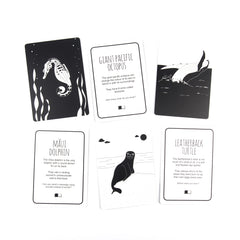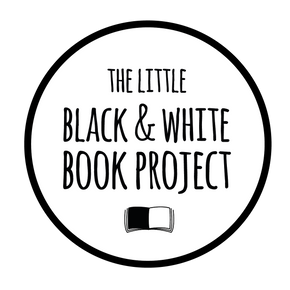
The benefits of high contrast illustrations in aiding the early development of vision in infants
The benefits of high contrast illustrations in aiding the early development of vision in infants
We are thrilled that Emma Davies, optometrist, kindly wrote this guest post about the science behind the black and white images in our books and how it is an important piece of early childhood development.
In a time before children...
When choosing a baby gift in a time BC ( before children ) I would have automatically gone to the baby section in a department store, selected a very cute outfit and had it gift wrapped. Having joined the ‘Parent Club’ myself 20 months ago my gift selection criteria is now very different. I look for something that will last, be durable and will facilitate sensory development in a fun way.
I stumbled across The Black and White Book Project a few months ago whilst looking for a gift for my colleague’s new baby, and the concept immediately caught my attention. As a practicing Optometrist I could appreciate the benefits the illustrations gave in aiding the early development of vision in infants, and as a parent saw the books as a lovely opportunity for parents to bond with their new baby and enhance communication skills right from day one.

The science
When we are born, despite the fact that our eyes start to develop early in the womb from week 4 of pregnancy, infants have very poor sight and limited colour vision. They will gaze into the mid distance and often the eyes will not coordinate well together. Over the initial few weeks of life infants will only be able to see items that are distinguishable by a distinct contrast in colour, the optimum combination being black and white, such as the bold images in Ruth’s beautifully designed illustrations.
"The more the eyes learn to coordinate,
the more accurate the eye movements become and
by default the more detail the eye and brain can detect"
the more accurate the eye movements become and
by default the more detail the eye and brain can detect"
When presented with such a target the baby’s visual pathway will be stimulated and the brain can work towards matching the images seen by each eye, in turn teaching the eyes to coordinate with one another. The more the eyes learn to coordinate, the more accurate the eye movements become and by default the more detail the eye and brain can detect, thus providing a continuous feedback and improvement system. Infants will start to detect colours a couple of months later starting with red and they will be able to see the full spectrum of colours by 5 months of age.
Testing eyesight in the early weeks
In a hospital setting if there is early concern that an infant is not developing the level of sight expected a test called ‘preferential looking’ is used to determine what the baby can see. Two screens are set up side by side. One has a flat, white illumination and the other has a grating ( black and white stripes).

If the baby can detect the difference in colour/contrast between the stripes, the brain will be stimulated and the eyes will automatically be drawn to looking at the screen with the stripes. The width of the stripes can be narrowed to determine how much detail the eyes can detect and therefore how developed they are. If the sight is poor and the infant can not see the stripes because their vision is too blurry, they will continue to gaze in random directions.
Well developed eye sight is something we all appreciate as being essential and so precious, but it is easy to forget how it links to other developmental milestones such as balance, coordination and communication.
Reading to bond and learn
As a new Mother one of my favourite ways to bond with my baby early on was to read to him. We did this religiously every day and I would point to illustrations naming them, describing them and, when appropriate, making the associated sounds. This has translated to a toddler who has communicated well from a very young age. Any parent will tell you that the joy you feel in watching your child learn, develop and master a new skill is unparalleled.
"Their baby will be able to start engaging with the
black and white illustrations from day one due to the
bold images and high level of contrast."
black and white illustrations from day one due to the
bold images and high level of contrast."
The VARK model is a widely accepted way of engaging the different ways people learn- visually, aurally (listening), reading, kinetically (physically doing/practicing the task). The Black and White Book Project provides the opportunity for parents to introduce the first three methods of learning in a gentle and fun way from the very beginning. Their baby will be able to start engaging with the black and white illustrations from day one due to the bold images and high level of contrast.
Whilst colour is fantastic at stimulating and engaging children it can also be very distracting. The simplicity that monochrome illustrations provides lends them well to imparting other information simultaneously. I found this worked really well with the flash cards that had fun facts on the reverse about the animal depicted in the image.
A gift that keeps giving
My colleague was delighted when she received the books and her 8week old boy instantly fixated on the illustrations and reached out to them. I have since received a pack for my 20month old and he is fascinated by the flash card pictures and turns them over so I can read the fun facts on the back ( in a silly voice of course!)


I know these beautiful products will become a long term staple in my household, in addition to my gift list for new parents, as they translate to hours of enjoyable learning and bonding, while simultaneously providing a stimulus to visual development in children from newborns through to toddlers.
Emma Davies
BSc( hons), MCOptom
BSc( hons), MCOptom

Emma Davies (Optometrist Director, BSc hons, MCOptom) trained at Anglia Ruskin University in Cambridge before returning to her home town in Shropshire to complete her post graduate training. She worked at Specsavers in Wellington for 7 years before becoming a Partner there. In her early career Emma worked with the Specsavers Professional Development team to facilitate peer training and later held the position of Continuous Education Training Coordinator for the Shropshire Local Optical Committee for 6 years.
Having achieved additional WOPEC qualifications in Enhanced Optical Services and accreditation for local Paediatric Vision Screening, Emma is hoping to pursue further training to gain a Professional Certificate in Paediatric Vision
















